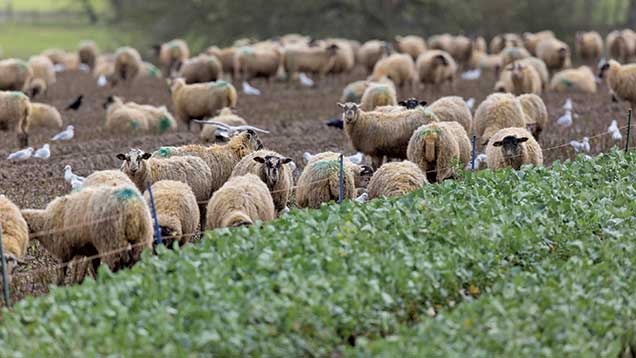Getting into sheep farming – how arable farmers can help
 Sheep grazing on turnips © Tim Scrivener
Sheep grazing on turnips © Tim Scrivener Collaborating with arable farmers and renting grass keep could help new entrants with limited capital get a foot on the sheep farming ladder.
Lack of capital was one of the hurdles identified by young people looking to get into the industry, who attended a joint event run by NSA Next Generation and RASE to inspire the next generation of sheep farmers.
However, sheep farmer Andrew Foulds said there was a real opportunity to start out in the industry by renting land and not being afraid to approach people.
See also: Ag college enlists farmers to train next generation
“Never be afraid to knock on people’s doors. I didn’t have the capital when I started out, but I knew a man who did so I knocked on his door and formed a business…Generally most people will be open to a chat,” he said at the event held at Abbey Home Farm, Cirencester.
Having bought his first three ewes in 1967, Mr Foulds and his business partner now run 2,100 ewes across various pockets of rented land in Suffolk and Norfolk. The only land owned is 16ha at West Row, which includes a farmhouse and buildings.
Overall, 320ha of summer grazing is rented from about five different producers. Through approaching various arable farmers, Mr Foulds has also developed a unique arrangement, where a total of 400ha of turnips are planted after crops such as winter barley and carrots. He then pays a headage fee for grazing.
“There’s room for collaboration with young sheep guys and arable producers. Arable farmers are generally worried about organic matter and the sheep help put muck back on the arable land,” explained Mr Foulds.
The flock is made up of Mule and Suffolk-cross Mule ewes, 1,800 lamb in January/February and 300 in April at the farm in West Row.
They then move on to turnips before going on to summer grazing. Mr Foulds also runs a separate business buying several thousand store lambs every year, which are kept on rented grassland and brassica waste.
Although the opportunity to take on rented ground in East Anglia may be greater due to reduced competition from livestock producers, there could still be opportunities elsewhere. Mr Foulds said the main thing when relying on rented ground was to ensure business relationships were maintained.
How are you going to get a foot on the sheep farming ladder?
 Kate and Dan Whittaker, Hinckley, Leicestershire – 30 Cambridge and Texel cross ewes
Kate and Dan Whittaker, Hinckley, Leicestershire – 30 Cambridge and Texel cross ewes
“We started by buying some cull ewes, fattening and selling them. We then bought some in-lamb ewes. We rented seven acres and since then we’ve been able to take on some grass from Dan’s boss who’s an arable farmer. Every sale we’ve made we’ve reinvested. We’ll keep an eye out for land and keep growing numbers.”
James Poulton, Guildford, Surrey – currently working in Horticulture
“I’m researching getting into agriculture. In October next year I’m going to start a graduate diploma in agriculture at Cirencester. I’ll then get experience on an arable and mixed farm, get the capital behind me and then one day hopefully have a farm.”
 James Drummond, Lemmington Hillhead, Northumberland – An NSA Next Generation Ambassador, working on family farm
James Drummond, Lemmington Hillhead, Northumberland – An NSA Next Generation Ambassador, working on family farm
“Rather than having a stratified breeding system, we’ve started to just breed Aberfields and become breeding partners with Innovis. Moving to that system is securing me a more profitable future.”
Pros and Cons of different routes into the sheep farming industry
The next generation of entrants into the sheep industry got to hear from five people who had taken different routes into the sector. They shared the pros and cons of each of their jobs:
|
Pros and Cons of different routes into the sheep farming industry |
||
|
Pros |
Cons |
|
|
Taking on the family farm (Marc Jones, Powys) |
|
|
|
Working in the service industry (Eileen McCloskey, sheep technologist, CAFRE) |
|
|
|
Managing a farm (Kevin Harrison, farm manager, Bath) |
|
|
|
Share farming (David Coates – share farming, North Yorkshire) |
|
|
|
Renting land (Andrew Foulds, Norfolk) |
|
|
